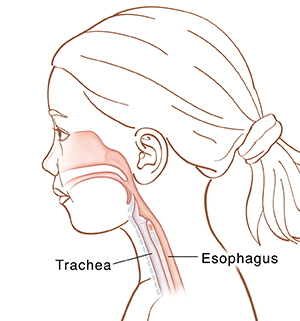A
B
C
D
E
F
G
H
I
J
K
L
M
N
O
P
Q
R
S
T
U
V
W
X
Y
Z
Click a letter to see a list of conditions beginning with that letter.
Click 'Topic Index' to return to the index for the current topic.
Click 'Library Index' to return to the listing of all topics.
When Your Child Swallows an Object
Young children often put small objects in their mouths, such as marbles, pins, or coins. These objects may be swallowed by accident. This can be scary. But it's not always cause for concern.
Most often, the object will pass through your child's body without harm. But in some cases, an object may become stuck in the tube leading from the mouth to the stomach (esophagus) or windpipe (trachea). In that case, your child needs medical care right away. Hours to days later, the object can become stuck in the intestine.

If you see your child, older than age 1, swallow a button battery, immediately start giving 1 to 2 teaspoons (5 to 10 ml) of honey every 10 minutes. (But don't do this if your child is allergic to honey.) Go to the emergency room right away to help prevent burns in the throat.
When to go to the emergency room (ER)
Contact your child's health care provider or seek medical care right away if you think your child has swallowed an object. Don't try to take the object out yourself. This may cause more harm.
Go to the ER if your child:
-
Has trouble breathing, speaking, or swallowing. (Call 911.)
-
Is spitting up saliva or vomiting.
-
Has chest pain, stomach pain, or pain when swallowing.
-
Is vomiting blood or passing blood from the rectum.
-
Has swallowed a button battery, a sharp object, or a magnet.
What to expect in the ER
-
A health care provider will ask about the swallowed object. Your child will get a physical exam.
-
X-rays may be taken to help find the object. This depends on your child's symptoms and what the object was. Not all objects can be seen on X-rays.
-
In some cases, your child may need a barium swallow test or a CT scan. One of these tests may be done if you think, but aren't sure, that your child swallowed an object, and it doesn't show up on an X-ray. In a barium swallow, your child drinks a thick liquid, and X-rays are then taken. CT scanning is a test that uses a series of X-rays. It may be done if the provider thinks an abscess has formed or is worried about a rupture of the digestive tract. This scan helps the provider see objects that may not show up on other tests.
Treatment
Treatment will depend on the type of object and where it's located. Your health care provider may suggest:
-
Watchful waiting. A smooth object that has not become stuck in the esophagus or the airway (trachea) may pass on its own in 24 hours or a few days. The object may be checked over time by a series of X-rays. Watchful waiting is not appropriate if your child has swallowed a button battery or multiple magnets.
-
Endoscopy. This is done to remove an object that has gone down the gastrointestinal tract and to check for any damage. A lighted tube (endoscope) is used. The scope is put down into the esophagus through the mouth. Your child will be given medicine so they sleep through the procedure. The object can be removed from the esophagus, stomach, or small intestine.
-
Bronchoscopy. This is done to remove an object that has gone down the windpipe (trachea) and into the lungs. A lighted tube is put down into the trachea through the mouth. Your child will be given medicine so they sleep through the procedure. The object can then be removed from the airway.
-
Surgery. If an object does not pass in a certain amount of time and can’t be taken out with a scope, your child may need surgery.
Follow-up
Contact your child's health care provider or return to the ER if your child:
-
Has nausea or vomiting.
-
Has bloody vomit or bloody stools.
-
Has severe belly pain or chest pain.
-
Has a fever of 100.4°F (38°C) or higher, or as directed by the provider.
Prevention
Clear your home of loose objects that can be swallowed by a child. This includes batteries (especially button batteries), loose magnets, and sharp objects.
Online Medical Reviewer:
Chelsey Schilling BSN RN
Online Medical Reviewer:
Lalitha Kadali
Online Medical Reviewer:
Rita Sather RN
Date Last Reviewed:
2/1/2025
© 2000-2025 The StayWell Company, LLC. All rights reserved. This information is not intended as a substitute for professional medical care. Always follow your healthcare professional's instructions.